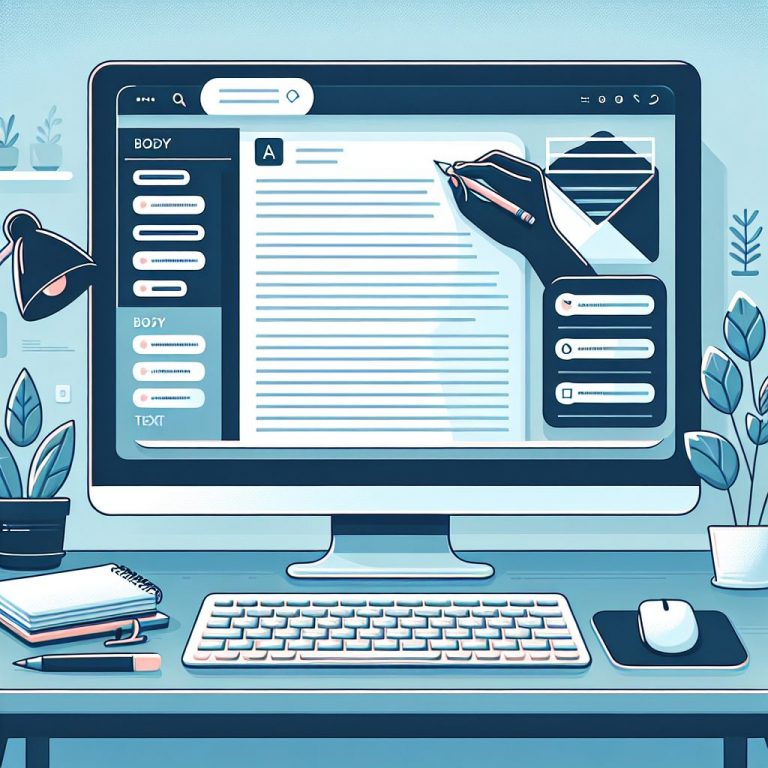Introduction to Email Communication
Email communication has become a cornerstone of professional and personal exchange. Understanding the components of an email is pivotal to leveraging its full potential for effective communication. Among these components, the body of an email plays a crucial role, serving as the nucleus where the message’s primary information is conveyed.

The body of an email is where the sender has the opportunity to connect with the recipient on a more personal level, regardless of the underlying professional context. This section is not just about relaying information; it’s about crafting a message that resonates with the recipient, ensuring clarity, tone, and intent are all aligned to the purpose of the communication. Understanding and mastering the art of email body writing can significantly enhance the effectiveness of your email communication, leading to better engagement and outcomes.
But why is the body of an email so important? It’s the space where the sender’s intentions, needs, and personality come to light. A well-crafted email body can make the difference between a message that is engaged with and one that is overlooked. It’s where you can employ strategies such as personalization, clear structuring, and the use of visual elements to make your message stand out. Despite the evolution of digital communication tools, email remains a fundamental channel, making the skills to effectively compose an email body invaluable for professionals across all sectors.
Curiosities and less-known facts about email communication underscore its complexity and the nuances involved in crafting the perfect email. For instance, the optimal length of an email body varies depending on the audience and purpose, but studies suggest that keeping it between 50 to 125 words can significantly increase response rates. Additionally, the strategic use of bullet points and visual aids within the email body can improve readability and recipient engagement, highlighting the importance of not just what you say, but how you say it.
In the realm of email communication, the body of an email is where the core message is conveyed, making it a pivotal element in achieving effective correspondence. Unlike the subject line, which serves as a brief preview or a hook designed to capture the recipient’s interest, the email body delves into the details, providing a comprehensive explanation, information, or request. It’s where the sender’s intentions are fully articulated, whether it’s for business proposals, personal messages, or informational broadcasts.
The distinction between the email body, subject line, and other components such as headers (which include the sender’s and recipient’s email addresses and the send date) and signatures (which may contain contact information, disclaimers, or social media links) is crucial for both the sender and the recipient. The body is the main content area sandwiched between these elements, and it’s formatted to facilitate readability and engagement. While the subject line grabs attention, the body of the email is tasked with holding it, using paragraphs, bullet points, and sometimes tables to present information in an organized manner.
Understanding the role and proper structuring of an email’s body can significantly impact the message’s effectiveness. For instance, keeping paragraphs short enhances readability, while highlighting key points in bold ensures that important information stands out. Moreover, integrating a clear call-to-action (CTA) can guide the recipient towards the desired response, be it replying, clicking a link, or completing a form. These strategies not only improve the user experience but also enhance the chances of achieving the email’s objective, whether that’s driving sales for a business or fostering meaningful communication on a personal level.
Best Practices for Email Body Content
Email marketing remains a critical tool for Sales Development Representatives, Sellers, and Account Managers aiming to improve outreach and conversion rates. Following best practices for the body content of your emails can significantly enhance your communication’s effectiveness. Here, we delve into the key strategies to optimize your email body content.
Keeping Your Message Clear and Concise
In the fast-paced world of sales, your email needs to stand out. The body of your email should be clear and concise, making it easy for recipients to understand your message at a glance. Avoid unnecessary jargon and keep paragraphs short for better readability. Bullet points can be an effective way to break down information, ensuring the main points are easily digestible.
Tailoring the Tone for Your Audience
The tone of your email should be carefully tailored to match your audience. Understanding the preferences and expectations of your recipients is crucial. A professional tone may be appropriate for B2B communications, while a more casual or friendly tone could engage B2C audiences effectively. Personalization goes beyond just addressing the recipient by name; it involves adapting your message to reflect their needs and interests, making the communication feel more personal and relevant.
Incorporating Visuals and Links
Visuals can significantly increase the engagement of your email content. Including relevant images or infographics can help illustrate your points more effectively. However, it’s important to use visuals sparingly and ensure they are directly relevant to your message. Links to your website, product pages, or useful resources can also provide value to your readers, encouraging them to explore further. Remember to use clear and compelling call-to-action (CTA) buttons or links, guiding recipients on what to do next.
Call to Action: Encouraging Reader Response
A clear call to action is paramount in driving engagement and responses from your email recipients. Whether you’re encouraging a reply, a sign-up, or a visit to your website, your CTA should be unmistakable and compelling. Use action-oriented language that incites enthusiasm or curiosity, prompting an immediate response. Positioning your CTA prominently within the email body ensures it cannot be missed.

Following the best practices for email body content is crucial for engaging your audience effectively. However, even with a clear and concise message, tailored tone, and strategic use of visuals and links, common mistakes in the email body can significantly undermine your efforts. Let’s delve into these pitfalls and how to avoid them, ensuring your email not only captures attention but also achieves its intended impact.
Overwhelming Recipients with Too Much Information
Keeping your email content focused is essential. While it’s tempting to include every detail about your offer or message, overwhelming your recipients with too much information can lead to disengagement. Recipients are likely to skim through emails, so highlight the key points and leave out unnecessary details. If more information is necessary, consider directing readers to a landing page or website for further details.
Ignoring the Importance of White Space
White space, or the use of empty space around text and visuals, is critical for making your email more readable and engaging. A cluttered email can be daunting and discourage readers from engaging with the content. Use paragraph breaks, bullet points, and spacing to create a visually appealing layout that guides the reader through your message effortlessly.
Neglecting Proofreading
Errors in spelling, grammar, or punctuation can significantly undermine your credibility and distract from your message. Neglecting proofreading is a common mistake that can be easily avoided. Take the time to review your emails carefully before sending them out, or use tools and services designed to catch errors. A well-proofed email reflects your professionalism and attention to detail, enhancing your recipients’ trust and engagement.
FAQ
- How can I ensure my email is not overwhelming?
- Focus on the key message, use bullet points for clarity, and direct readers to external links for additional information.
- Why is white space important in email design?
- White space improves readability, guides the reader through the content, and creates a visually appealing layout that encourages engagement.
- What are some effective proofreading tips?
- Read your email aloud, use spell-check tools, and consider having a colleague review it for an additional layer of scrutiny.







